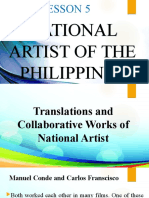0 ratings0% found this document useful (0 votes)
731 viewsNeorealism-: Cesar Legaspi - Is Remembered For
Neorealism-: Cesar Legaspi - Is Remembered For
Uploaded by
Dunhill Guantero- Neorealism is a cultural movement that depicts realistic elements of everyday life rather than an imaginary world. It was developed in Europe after World War II.
- Neorealism in painting was established in the early 20th century by British artists Charles Ginner and Harold Gilman, who sought to explore the spirit of their age through daily life's shapes and colors.
- Cesar Legaspi was a Filipino artist remembered for refining cubism with Philippine themes. He belonged to the Neorealist movement and created works reflecting post-war industrialization like "Gadgets."
Copyright:
© All Rights Reserved
Available Formats
Download as DOCX, PDF, TXT or read online from Scribd
Neorealism-: Cesar Legaspi - Is Remembered For
Neorealism-: Cesar Legaspi - Is Remembered For
Uploaded by
Dunhill Guantero0 ratings0% found this document useful (0 votes)
731 views3 pages- Neorealism is a cultural movement that depicts realistic elements of everyday life rather than an imaginary world. It was developed in Europe after World War II.
- Neorealism in painting was established in the early 20th century by British artists Charles Ginner and Harold Gilman, who sought to explore the spirit of their age through daily life's shapes and colors.
- Cesar Legaspi was a Filipino artist remembered for refining cubism with Philippine themes. He belonged to the Neorealist movement and created works reflecting post-war industrialization like "Gadgets."
Original Description:
Neorealsim
Original Title
n e o r e a l i s m
Copyright
© © All Rights Reserved
Available Formats
DOCX, PDF, TXT or read online from Scribd
Share this document
Did you find this document useful?
Is this content inappropriate?
- Neorealism is a cultural movement that depicts realistic elements of everyday life rather than an imaginary world. It was developed in Europe after World War II.
- Neorealism in painting was established in the early 20th century by British artists Charles Ginner and Harold Gilman, who sought to explore the spirit of their age through daily life's shapes and colors.
- Cesar Legaspi was a Filipino artist remembered for refining cubism with Philippine themes. He belonged to the Neorealist movement and created works reflecting post-war industrialization like "Gadgets."
Copyright:
© All Rights Reserved
Available Formats
Download as DOCX, PDF, TXT or read online from Scribd
Download as docx, pdf, or txt
0 ratings0% found this document useful (0 votes)
731 views3 pagesNeorealism-: Cesar Legaspi - Is Remembered For
Neorealism-: Cesar Legaspi - Is Remembered For
Uploaded by
Dunhill Guantero- Neorealism is a cultural movement that depicts realistic elements of everyday life rather than an imaginary world. It was developed in Europe after World War II.
- Neorealism in painting was established in the early 20th century by British artists Charles Ginner and Harold Gilman, who sought to explore the spirit of their age through daily life's shapes and colors.
- Cesar Legaspi was a Filipino artist remembered for refining cubism with Philippine themes. He belonged to the Neorealist movement and created works reflecting post-war industrialization like "Gadgets."
Copyright:
© All Rights Reserved
Available Formats
Download as DOCX, PDF, TXT or read online from Scribd
Download as docx, pdf, or txt
You are on page 1of 3
-N E O R E A L I S M-
-is also termed as “structured realism” and a few writers
sometimes refer to their theories simply as “realist” to emphasize
the continuity between their own and older views.
-is a cultural movement that brings elements of true life in the
stories it describes, rather than a world mainly existing in
imagination only. The movement was developed in Europe,
primarily after the end of World War II.
-Neorealism in painting was established by the ex-Camdem Town
Group painters Charles Ginner and Harold Gilman at the
beginning of World War I. They set out to explore the spirit of
their age through the shapes and colors of daily life.
Artist (Philippines)
Cesar Legaspi – is remembered for
the singular achievement of refining
cubism in the Philippine context.
Legaspi belonged to the so-called
“Thirteen Moderns” and later, the “Neo-
realist”. Among his works are Gadgets
I, Gadgets II, Diggers, Idols of the
Third Eye, Flora and Fauna, The
Survivor and many more.
Cesar Legaspi’s Works
“Gadgets,” 1947, done in
two versions, reflects the
increasing importance of
machines in the post-war
industrialization period, as
well as what he perceived
was the insidious threat of
human metamorphosing
into machine.
Through the 1970s and
1980s, Legaspi paintings
that deal with universal
human experience, such as
The Survivor. These large,
heroic canvases, done in
his dynamic style, convey
the surging, straining
movements of human
beings in aspiration, struggle, and triumph.
Artist(International):
Ashot Melkonian - was an
Armenian artist associated with
Neorealistic artistic style. He
mainly devoted himself to
landscape and portraits painting
as well as murals and he is one of
the founders of Neorealism in
Armenian art. Among his works
are Boy with a book, Armen, and
Murals.
Ashot Melkonian’s Works
The trees and the
flowers in the painting
are viewed as symbols of
tender that unites the
family,the "Family" came
as a proof of Melkonian's
artistic maturity. Its most
characteristic features
are the precise simplicity
of drawing, the richness
of substance and bold
statement of values adopted by the new school of Armenian
painting that emerged in the 1960s.
You might also like
- Lesson 9: Caught in Between: Modern and Contemporary ArtDocument18 pagesLesson 9: Caught in Between: Modern and Contemporary ArtExcelsis Joy Ramos88% (16)
- Science Investigatory ProjectDocument25 pagesScience Investigatory ProjectDunhill Guantero100% (2)
- Timeline of Philippine Arts: ERA Time Characteristics Distinct FeaturesDocument2 pagesTimeline of Philippine Arts: ERA Time Characteristics Distinct FeaturesJanine Ginog FerrerNo ratings yet
- Final Research Proposal2.oDocument24 pagesFinal Research Proposal2.oDunhill Guantero50% (2)
- RRLDocument7 pagesRRLDunhill Guantero75% (4)
- DLL Grade 8 Arts 2nd QuarterDocument5 pagesDLL Grade 8 Arts 2nd QuarterKD Magbanua100% (4)
- Module 6: The National Artists of The Philippines For LiteratureDocument31 pagesModule 6: The National Artists of The Philippines For LiteratureGenelNo ratings yet
- A GabuDocument4 pagesA GabuKaly RieNo ratings yet
- Gawad Manlilikha NG Bayan (GAMABA)Document12 pagesGawad Manlilikha NG Bayan (GAMABA)APRIL ANN ABADILLANo ratings yet
- Module 1Document10 pagesModule 1lyn80% (10)
- The Literary Forms in Philippine LiteratureDocument29 pagesThe Literary Forms in Philippine LiteratureJohannin Cazar ArevaloNo ratings yet
- Unit 3: Recognizing The GAMABA and The National ArtistsDocument17 pagesUnit 3: Recognizing The GAMABA and The National ArtistsAngel CamatNo ratings yet
- 21st Century LiteratureDocument20 pages21st Century LiteratureBelinda Dela Cruz UrbanoNo ratings yet
- National ArtistsDocument68 pagesNational ArtistsCaesar M. AmigoNo ratings yet
- Abdul Mari Asia ImaoDocument10 pagesAbdul Mari Asia ImaoAlyanna Elisse VergaraNo ratings yet
- CNF ReviewerDocument11 pagesCNF Reviewermarielmaxenne.dorosan.cvtNo ratings yet
- Contemporary Arts Lecture Handouts (Module (15-21)Document9 pagesContemporary Arts Lecture Handouts (Module (15-21)Julie Anne Portal - Odasco100% (1)
- Philtech Institute of Arts and Technology Inc.: LESSON 2: Elements of DanceDocument3 pagesPhiltech Institute of Arts and Technology Inc.: LESSON 2: Elements of DanceJoe LevinneNo ratings yet
- Levi Celerio Biography: Filipino FolkDocument7 pagesLevi Celerio Biography: Filipino FolkAckociemizyhel Pasco EspinolNo ratings yet
- Contemporary Philippine Arts From The Regions 12Document3 pagesContemporary Philippine Arts From The Regions 12Julienne Mae N. MahometanoNo ratings yet
- Art Appreciation: Alonzo SaclagDocument2 pagesArt Appreciation: Alonzo SaclagCarlo AtaderoNo ratings yet
- My Other Name by Gilford DoquilaDocument7 pagesMy Other Name by Gilford DoquilaMargie PrecillasNo ratings yet
- Red GenotivaDocument12 pagesRed Genotivajamaoding.pandaNo ratings yet
- National Artist of The Philippines in Literature: By: Charmaine mUNOZ, Perlyne Corioso Roger Visto, OLIVER GAMILLADocument16 pagesNational Artist of The Philippines in Literature: By: Charmaine mUNOZ, Perlyne Corioso Roger Visto, OLIVER GAMILLAAlleah Grace JuguanNo ratings yet
- Magdalenian IndustryDocument8 pagesMagdalenian IndustryLyrics & Songs100% (1)
- TimelineDocument2 pagesTimelinefranchesca latido100% (3)
- Lesson 5: National Artist of The Philippines National Artist of The PhilippinesDocument14 pagesLesson 5: National Artist of The Philippines National Artist of The PhilippinesAliyah PlaceNo ratings yet
- Life of Jose Corazon de JesusDocument1 pageLife of Jose Corazon de JesusErosNo ratings yet
- WritersDocument10 pagesWritersBeepoy BrionesNo ratings yet
- CPAR 12 ProjectDocument26 pagesCPAR 12 ProjectErly CambasNo ratings yet
- Reviewer Impact of 21ST Century To Philippine LiteratureDocument1 pageReviewer Impact of 21ST Century To Philippine LiteratureEliana DuldulaoNo ratings yet
- GAMABADocument28 pagesGAMABAJoy Caligan PagariganNo ratings yet
- The Safe House SummaruDocument2 pagesThe Safe House SummaruJessie John V. VillameroNo ratings yet
- 3 Key Time Frames of The Development of Philippine Lit in The American Period Include Writers and Works From These ErasDocument2 pages3 Key Time Frames of The Development of Philippine Lit in The American Period Include Writers and Works From These ErasMarcus Dylan CabalNo ratings yet
- Nick JoaquínDocument12 pagesNick Joaquínrenzocute330% (1)
- 21st Century L2Document24 pages21st Century L2jennalyn caracasNo ratings yet
- National Artist For LiteratureDocument52 pagesNational Artist For LiteratureDimphna Jel Pacifico100% (1)
- 21st Century Third World GeographyDocument3 pages21st Century Third World GeographyMae Baltera0% (1)
- 21st Century Literature From The PhilippinesDocument13 pages21st Century Literature From The PhilippinesCHRISTINE MEMITA100% (1)
- Ang KiukokDocument3 pagesAng KiukokMELISSA PANAGANo ratings yet
- Inspiring Life Story of Francisco Arcellana ManuscriptDocument8 pagesInspiring Life Story of Francisco Arcellana ManuscriptNatalie Irish VillanuevaNo ratings yet
- Carlos Modesto Villaluz "Botong" FranciscoDocument9 pagesCarlos Modesto Villaluz "Botong" Franciscovamps sierNo ratings yet
- GAMABA Teofilo GarciaDocument1 pageGAMABA Teofilo GarciaLynn CastillonNo ratings yet
- Dead Poets Society: Exposition/Introduction - It Was The Start of The Semester and TheyDocument2 pagesDead Poets Society: Exposition/Introduction - It Was The Start of The Semester and TheyGlazy Kim Seco - JorquiaNo ratings yet
- Italian LiteratureDocument42 pagesItalian LiteratureparaibologoNo ratings yet
- Poem AnalysisDocument2 pagesPoem AnalysisDailyn VergaraNo ratings yet
- FINAL COPY SHS 21st Century Literature Q1 M2Document24 pagesFINAL COPY SHS 21st Century Literature Q1 M2Lee Arne Barayuga50% (2)
- National Living Treasures Award: Gawad Sa Manlilikha NG BayanDocument19 pagesNational Living Treasures Award: Gawad Sa Manlilikha NG Bayan孙美美Ezra Paola Tayson100% (1)
- Context of ArtsDocument17 pagesContext of ArtsGil forobleNo ratings yet
- Ang KiukokDocument12 pagesAng Kiukokphildian viralNo ratings yet
- Parañaque: A Walk Through Art and TimeDocument2 pagesParañaque: A Walk Through Art and TimePatrizia LagramadaNo ratings yet
- Japanese Colonial PeriodDocument19 pagesJapanese Colonial Periodjoanna reignNo ratings yet
- National Artists For LiteratureDocument3 pagesNational Artists For LiteratureMiguela LabiosNo ratings yet
- (Interpretation) Apo On The Wall by BJ PatinoDocument3 pages(Interpretation) Apo On The Wall by BJ PatinoTina ManforteNo ratings yet
- Artist From LuzonDocument16 pagesArtist From LuzonJane GeronimoNo ratings yet
- 21st Century Literature Week 1 PDFDocument25 pages21st Century Literature Week 1 PDFCecilia ReyesNo ratings yet
- Silk Discussion/ Review: Prepared By: Levy P. CoronelDocument30 pagesSilk Discussion/ Review: Prepared By: Levy P. CoronelLevy Coronel0% (1)
- Leonor GoquingcoDocument27 pagesLeonor GoquingcoMargaux Radam100% (2)
- Levi Celerio Power PointDocument5 pagesLevi Celerio Power PointHeinrich SiangcoNo ratings yet
- Contemporary & Modern PeriodDocument11 pagesContemporary & Modern Periodleiste zeitNo ratings yet
- Cavite Contemporary Art PDFDocument4 pagesCavite Contemporary Art PDFKennethBermudezNo ratings yet
- Filipino Artist in Central LuzonDocument43 pagesFilipino Artist in Central LuzonAllyzha AguilarNo ratings yet
- The Evolution of Hip Hop Dance in The Philippines PDFDocument23 pagesThe Evolution of Hip Hop Dance in The Philippines PDFCj CastilloNo ratings yet
- A Rose For Emily MarxistDocument3 pagesA Rose For Emily Marxistapi-288282286100% (1)
- Electromagnetism: Self-Sustaining Portable Generator Through Magnets, Old Speaker, and MotorDocument8 pagesElectromagnetism: Self-Sustaining Portable Generator Through Magnets, Old Speaker, and MotorDunhill GuanteroNo ratings yet
- Electromanitism: Self-Sustaining Portable Generator Through Magnets, Old Speaker, and MotorDocument8 pagesElectromanitism: Self-Sustaining Portable Generator Through Magnets, Old Speaker, and MotorDunhill GuanteroNo ratings yet
- The Theory of Everything Movie AnalysisDocument6 pagesThe Theory of Everything Movie AnalysisDunhill GuanteroNo ratings yet
- Detailed Lesson Plan in Impressionism (Arts)Document7 pagesDetailed Lesson Plan in Impressionism (Arts)Gladys Mae Linto Millena100% (4)
- Fine ArtDocument11 pagesFine ArtSumit RpNo ratings yet
- Fernand LégerDocument6 pagesFernand LégersubirNo ratings yet
- Department of EducationDocument2 pagesDepartment of EducationRienalyn Galsim100% (1)
- Module 2 in ContemporaryDocument12 pagesModule 2 in ContemporarySirLance ValerioNo ratings yet
- Primal Flow Painting For All! - Kegan KiddDocument42 pagesPrimal Flow Painting For All! - Kegan KiddDavis Flores67% (3)
- Comparative Analysis Between Art and Architecture: OMALE Reuben Peters & Ogunmakinde OlabodeDocument18 pagesComparative Analysis Between Art and Architecture: OMALE Reuben Peters & Ogunmakinde OlabodeNathasha KudasingheNo ratings yet
- Artists Magazine - May-June 2023Document84 pagesArtists Magazine - May-June 2023Victoria DereckNo ratings yet
- Contemporary Arts ReviewerDocument5 pagesContemporary Arts ReviewerIsabel HontiverosNo ratings yet
- Conarts ReviewerDocument3 pagesConarts ReviewerAvianna RyeNo ratings yet
- E-Day (Info-Eduard Special) - 2023Document52 pagesE-Day (Info-Eduard Special) - 2023ervadNo ratings yet
- Tsuruya Etd2005revDocument310 pagesTsuruya Etd2005revOdalisaCuevasNo ratings yet
- Essay Literary Essay SampleDocument8 pagesEssay Literary Essay SampleJohn RandeyNo ratings yet
- Unit 1 Art AppDocument31 pagesUnit 1 Art AppAngelica BuquelNo ratings yet
- DLL - Mapeh 3 - Q2 - W1Document3 pagesDLL - Mapeh 3 - Q2 - W1Clarissa Rollan PorioNo ratings yet
- Art Objectives 3 /4 Class Concepts and Skills An Awareness of LineDocument4 pagesArt Objectives 3 /4 Class Concepts and Skills An Awareness of LineRatkoMRNo ratings yet
- Amit Dutta BOMB 141Document5 pagesAmit Dutta BOMB 141srikanthsrinivasanNo ratings yet
- PicassoDocument3 pagesPicassoAurel DeduNo ratings yet
- Contempo Arts Module 9 Hand OutsDocument23 pagesContempo Arts Module 9 Hand OutsJosh RelNo ratings yet
- Georgia O'KeeffeDocument20 pagesGeorgia O'KeeffeTrizeqNo ratings yet
- CPAR 3rd Quarter ExamDocument3 pagesCPAR 3rd Quarter ExamSORAHAYDA ENRIQUEZ100% (1)
- Studio Art Introduction and Course OutlineDocument6 pagesStudio Art Introduction and Course OutlineGrade SevenNo ratings yet
- Reflections: 1. Why Is Form Essential To Art? How Is Form Expressed or Perceived in Art?Document4 pagesReflections: 1. Why Is Form Essential To Art? How Is Form Expressed or Perceived in Art?FRANCIS VALE NAVITANo ratings yet
- Art AppDocument2 pagesArt AppBilly HilarioNo ratings yet
- Chicago Art Deco Society HavanaDocument112 pagesChicago Art Deco Society Havanaarquitecturacuba100% (3)
- Dream of A Sunday Afternoon in Alameda Central Park WeeblyDocument2 pagesDream of A Sunday Afternoon in Alameda Central Park Weeblyapi-329166680No ratings yet
- 14-Maynard 1977Document16 pages14-Maynard 1977Daniela Valenzuela R.100% (1)
- Martin - 1905 - The Life of A Dutch Artist in The Seventeenth CentDocument10 pagesMartin - 1905 - The Life of A Dutch Artist in The Seventeenth CentLauraufrrNo ratings yet































































































